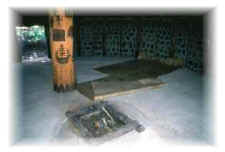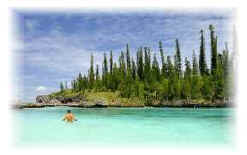|
|
|||||||||||||||||||||||||||||||||||||||||||||||
|
|
|||||||||||||||||||||||||||||||||||||||||||||||
The various languages in New Caledonia
There are in New Caledonia, several dozens different languages, among which the French (official language), 28 vernacular languages and numerous languages, spoken by ethnic minorities.
The French language, the official language The French language, at first spread with the establishment of French colonists, will be appointed in schools, by decree, in the first years which followed the annexation by France (decree GUILLAIN, in 1863). The obligation to teach only in French (1863), and then, later, the change of the Protestant missionary supervision (in 1891, the Missions de Paris Society will relieve the Missions of London Society) and the ban to publish in autochthonous languages (1921), will favor the extension. But, even if the French language can be meet in the most secluded tribes, the mastery of this language remains variable in the whole population. The variety of this mastery is due, first of all, to the schooling of the individuals. The access to the public school, for the young Melanesians, became only widespread since 1953. So, there is no wonder to hear, old autochthons using an approximate French. The Indo-Chinese and Javanese immigrants, as more recently, the Polynesian and Wallinesian immigrants, will not be more favored. This variety of mastery is also due to the variety of ethnic groups living in New Caledonia. One could say that in New Caledonia, there are as many ways to speak French as social groups, even social stocks.
The Melanesian languages
The languages of the ethnic minorities They are those of the communities of Wallinesian and Polynesian descent (Polynesian languages), Vietnamese, Indonesian, Caribbean (Creole language), Vanuatu descent (bichlamar), ... Grouping together more than 40.000 individuals, these communities, product of the immigration, form what one could call non-territorial linguistic and cultural minorities. The languages of these minorities localize essentially in Nouméa and the suburb, however except the Polynesian languages rather represented in the mining centers. Unequal spoken because of the numerical importance of the speakers ; they are also unequal true to the colloquial language of the home countries, because of their nearness or distance, of time and space. So if one can say that the important Wallinesian and Polynesian communities, who maintained privileged relationships with their close territories, have "the most true" languages, it is not true for Vietnamese and Indonesian of the "second generation", and the descendants of distant Kabyle deportees (1870 rebels).
According
to the information brochure written by Léonard,
Drilë, SAM
|
|
||||||||||||||||||||||||||||||||||||||||||||||
|
|
|||||||||||||||||||||||||||||||||||||||||||||||





